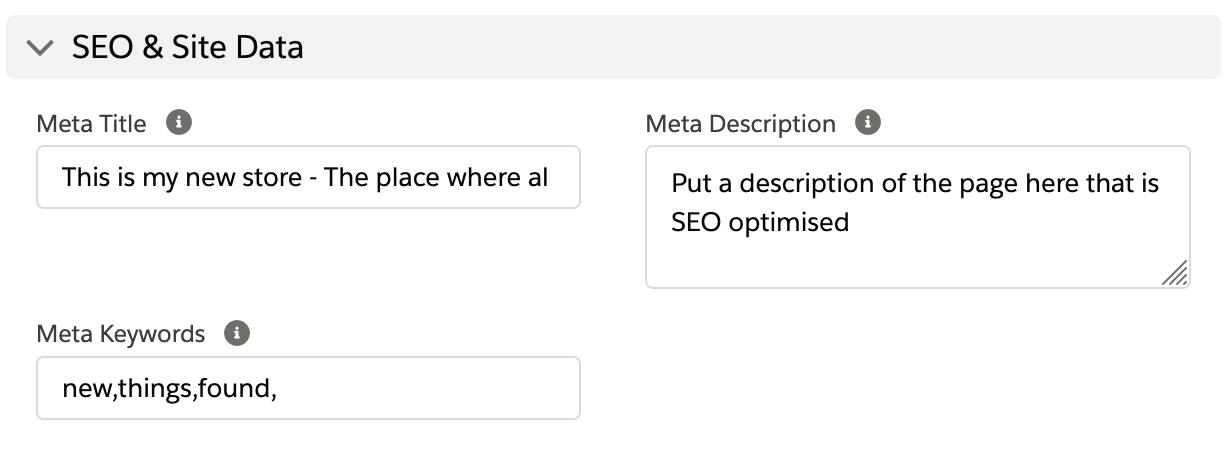SEO and Site Data
Search Engine Optimisation1 (SEO) is the process of improving a website’s visibility on search engines.
No one knows the proprietary systems search engines such as Google use to rank websites. However, it is a commonly known fact that they do make use of “META” data (information).
META simply means “self-referring” or “how something or someone would refer to themselves”
In this case, a website would use META data in order to define how it refers itself, so when search engines find the website they know how to classify it.
SEO Fields
There are 3 SEO fields that you might consider populating throughout your stores:
Meta Title recommended
This is the name of your store (website) as you would want a browser to display it. It is used by search engines when searching the internet.
Meta Description recommended
These fields exist for several objects and the SEO fields on the store object act as a default for any pages in that store that don’t have their own SEO metadata.
Meta Keywords recommended
Enter any keywords2 that will help search engines find your store.
| Metadata Field | Usage |
|---|---|
| Meta Title | 50 - 60 characters describing the page |
| Meta Description | The description that shows up on search results. Usually less than 300 characters |
| Meta Keywords | Comma separated words or phrases to indicate what the page is about |
What Meta Data is Inserted

What your customer is looking at on the store will determine which set of meta data is inserted into the page currently being viewed.
A full description of each type is detailed in our Dynamic Page Information Fields help article.
How to make SEO Fields available
In some cases, such as the product object, the meta fields are not displayed by default. In such case, you will need to change the assigned page layout or add the field to your config page layout. Please, refer to Change Config Page Layout.
In some cases, such as the product object, the meta fields are not displayed by default. In such case, you will need to change the config page layout. Please, refer to Change Config Page Layout.
In some cases, such as the product object, the meta fields are not displayed by default. In such case, you will need to change the assigned page layout or add the field to your config page layout. Please, refer to Change Config Page Layout.
Site Data Details for the Store
These fields exist for several objects and the SEO fields on the store object act as a default for any pages in that store that don’t have their own SEO metadata.
You can provide these records with SEO Metadata:
- Stores
- Location Group
- Locations
- Pages
- Article Categories
- Articles
- Product Categories
- Products
Other content on your pages and articles can also assist SEO including content block text and text within fields like Introduction and Information on the Product Category pages.
Default Values
Each record with meta data fields will try and return an intelligent default value if the meta data fields are blank. These default values are used for the page meta data as well as the description within the merchant feeds for products. These default values are calculated as follows:
The below shows the sequence of priority the StoreConnect system attempts to display your meta data, coming up with intelligent default values.
Where an entry says “Store” it means that the content is gotten from the Store records as a fall back.
For example, the Product meta title is first going to return any value within the Product2.s_c__Meta_Title__c field, if this is blank, it will return whatever the value is within the Product2.s_c__Display_Name__c field, if this is blank it will then return whatever is in the Product2.Name field, if this is somehow blank, it will return the value that Store Meta Title returns (which usually should never happen).
The full list of default values for each record type follows:
Products
- Meta Title:
s_c__Meta_Title__c->s_c__Display_Name__c->Name-> Store - Meta Keywords:
s_c__Meta_Keywords__c-> Store - Meta Description:
s_c__Meta_Description__c->s_c__Search_Description__c->s_c__Summary_Markdown__c-> Brand Names plus Prooduct Name
Product Categories
- Meta Title:
s_c__Meta_Title__c->s_c__Display_Name__c->s_c__Title__c-> Store - Meta Keywords:
s_c__Meta_Keywords__c-> Store - Meta Description:
s_c__Meta_Description__c->s_c__Introduction_Markdown__c->s_c__Information_Markdown__c-> Store
Articles
- Meta Title:
s_c__Meta_Title__c->s_c__Title__c->Name-> Store - Meta Keywords:
s_c__Meta_Keywords__c-> Title -> Store - Meta Description:
s_c__Meta_Description__c->s_c__Intro_Markdown__c->s_c__Summary_Markdown__c-> Store
Article Categories
- Meta Title:
s_c__Meta_Title__c->s_c__Display_Name__c->Name-> Store - Meta Keywords:
s_c__Meta_Keywords__c-> Title -> Store - Meta Description:
s_c__Meta_Description__c->s_c__Introduction_Markdown__c->s_c__Information_Markdown__c-> Store
Pages
- Meta Title:
s_c__Meta_Title__c->s_c__Title__c->Name-> Store - Meta Keywords:
s_c__Meta_Keywords__c->s_c__Meta_Title__c-> Store - Meta Description:
s_c__Meta_Description__c-> Store
Locations
- Meta Title:
s_c__Meta_Title__c->s_c__Display_Name__cplus Loccation Group Title, or Store - Meta Keywords:
s_c__Meta_Keywords__c->s_c__Meta_Title__c-> Store - Meta Description:
s_c__Meta_Description__c-> Store
Location Group
- Meta Title:
s_c__Meta_Title__c->s_c__Display_Name__c->Name-> Store - Meta Keywords:
s_c__Meta_Keywords__c->s_c__Meta_Title__c-> Store - Meta Description:
s_c__Meta_Description__c-> Store
Stores
- Meta Title:
s_c__Meta_Title__c->Name - Meta Keywords:
s_c__Meta_Keywords__c->s_c__Meta_Title__c - Meta Description:
s_c__Meta_Description__c
Order of Priority
Given that you can be viewing an article, which is within an article category, that is within a store, there are multiple meta titles, description and keywords fields that could be returned.
The meta data is returned in the following order of priority:
- Products
- Product Categories
- Articles
- Article Categories
- Pages
- Locations
- Location Group
- Stores
So if you are showing a Product, it’s meta data will be returned instead of the Store (or any other meta data).
Basic Configuration of the StoreConnect Config App
Email Settings < Back | Next > Content Management (CMS)
Back to Documentation